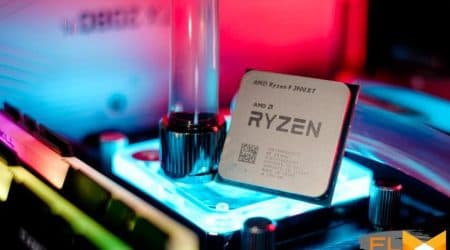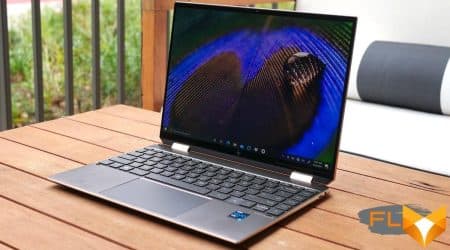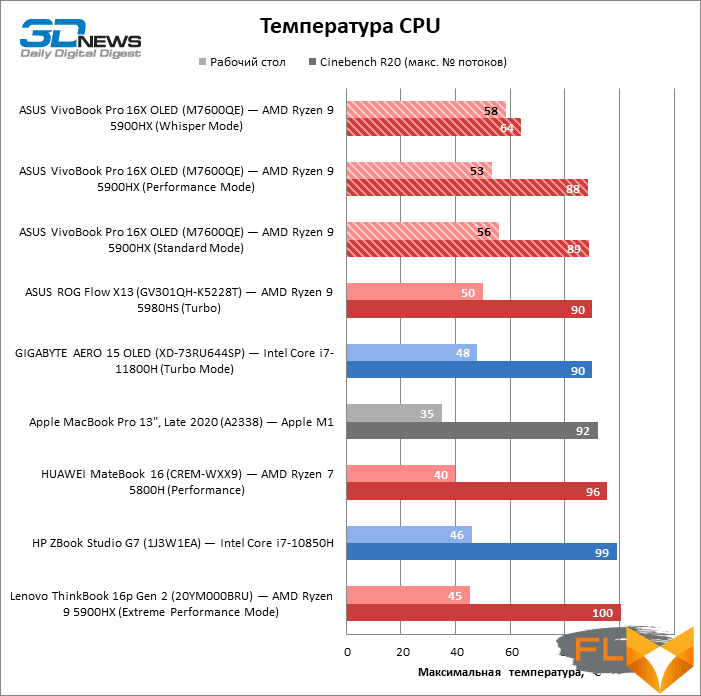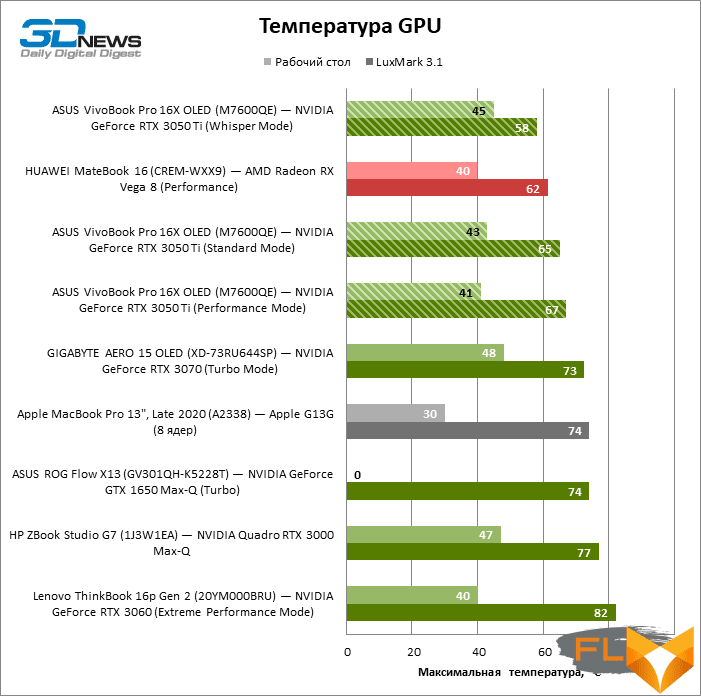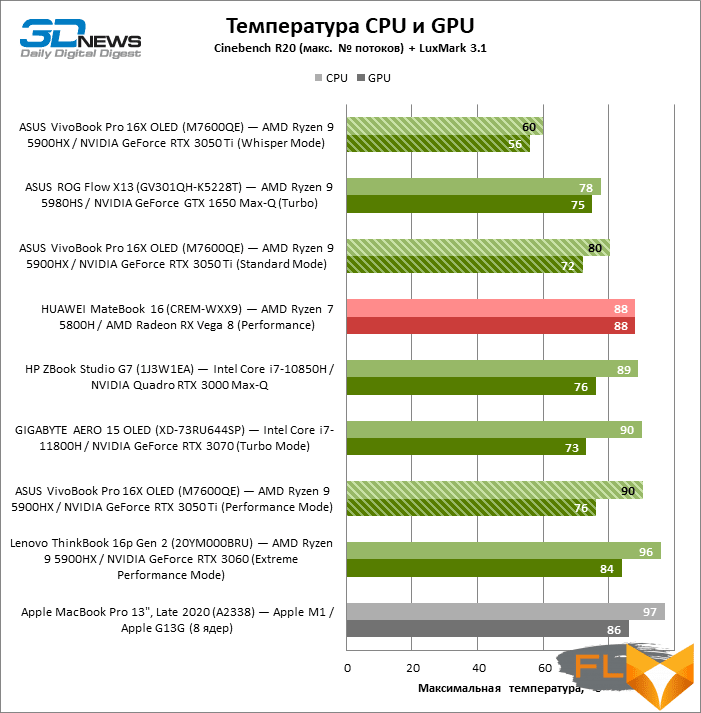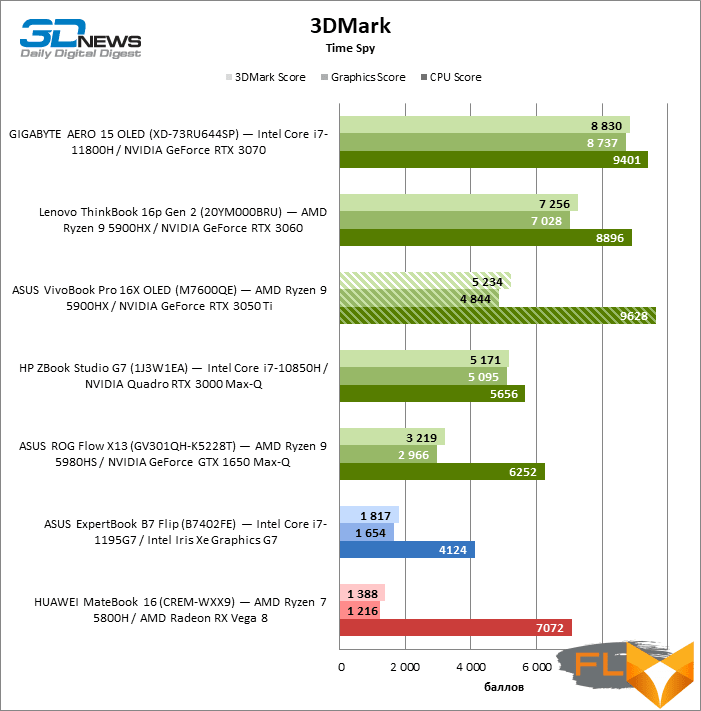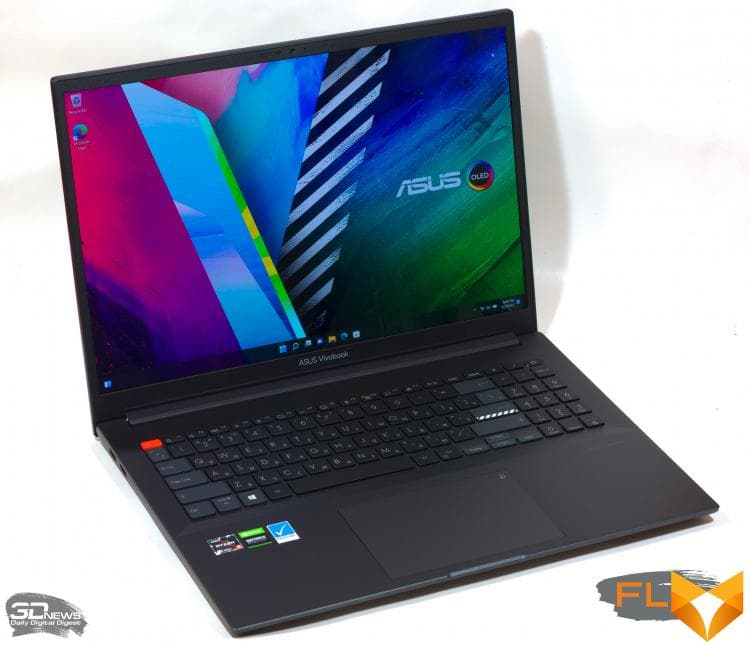


We’ve seen quite a few 16″ laptops. The new format is well-deservedly popular and will likely replace typical 15.4-inch matrices in the future, just as 14-inch ultrabooks have now almost completely replaced their 13-inch predecessors. That being said, it’s encouraging to see that many manufacturers are opting for 16:10 aspect ratio panels, which provide more screen real estate than 16:9 and allow it to be used more effectively in most workloads.
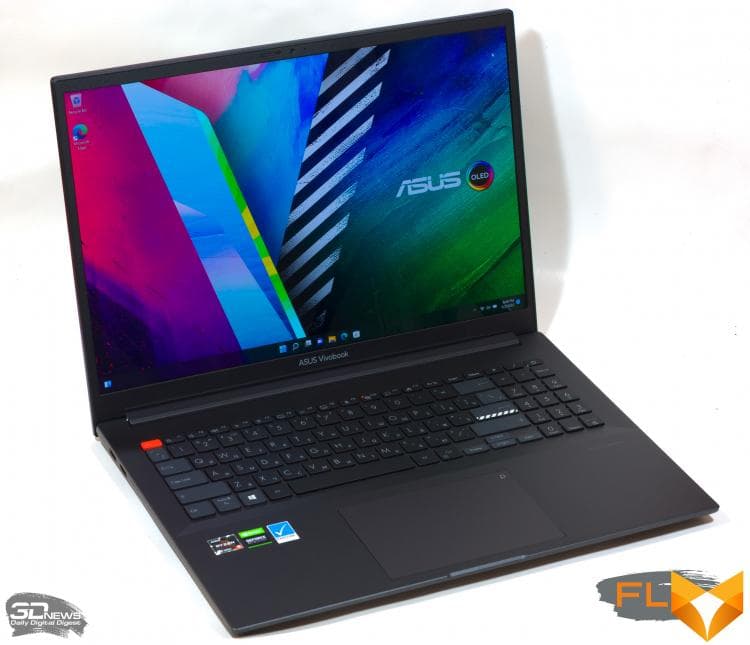
But the question of choosing between IPS and OLED, while panels with Mini LED backlighting is still extremely rare, remains open. ASUS, which has long used OLED, offered digital content creators or simply those who are in search of a good all-round laptop, related devices under the VivoBook Pro 16X brand: one (N7600) based on 11th generation Intel processors, the second (M7600) -on AMD Ryzen 5000 series chips. Today we will look at the last, more powerful option.
⇡#Specifications, prices
The red variant of the VivoBook Pro 16X OLED comes with Ryzen 5000-series CPUs: the top six-core Ryzen 5 5600H, the eight-core Ryzen 7 5800H, or the Ryzen 9 5900HX. The difference between the two older models lies in the clock speeds of x86 cores and integrated graphics. However, the last point does not matter for the performance of the VivoBook Pro 16X OLED, since the laptop has a fairly powerful discrete video chip: GeForce RTX 3050 or RTX 3050 Ti. The only pity is that, unlike desktop graphics cards of the same name, mobile ones have only 4 GB of their own memory, and this is a serious limitation in some work tasks. By the way, the Ti version of the RTX 3050 is only available in the VivoBook Pro 16X OLED modification on the AMD platform, while ASUS combines Intel chips with the regular RTX 3050.
The amount of RAM is 8GB, 16GB, or 32GB DDR4. The buyer needs to decide on this parameter in advance: all the chips are soldered on the motherboard, and there are no SO-DIMM slots. In turn, the SSD holds 512 GB or 1 TB of data.
| Manufacturer | ASUS |
|---|---|
| Model | VivoBook Pro 16X OLED (M7600) |
| Display | 16”, 3840 × 2400, OLED |
| CPU | AMD Ryzen 9 5900HX (8/16 cores/threads, 3.3-4, 6 GHz); AMD Ryzen 7 5800H (8/16 cores/threads, 3.2-4.4GHz); AMD Ryzen 5 5600H (6/12 cores/threads, 3.3-4.2GHz) |
| RAM | DDR4 SDRAM, 3200 MT/s, 8-32 GB (2 channels) span> |
| GPU | NVIDIA GeForce RTX 3050 Ti (4 GB); NVIDIA GeForce RTX 3050 (4GB) |
| Accumulator | SK Hynix BC711 (PCIe 3.0 x4), 512/1024GB |
| External I/O connectors | 1 × USB 3.1 Gen 1 Type-C; 1 × USB 3.1 Gen 1 Type-A; 2 × USB 2.0 Type-A; 1 × HDMI; 1 × microSD; 1 × TRS 3.5mm |
| Network | IEEE 802.11ax; Bluetooth 5.0 |
| Battery capacity, Wh | 96 |
| Weight, kg | 1.95 |
| Overall dimensions (L × W × H), mm | 360.5 × 259 × 18.9 |
| Retail price | From $2,300 (AMD Ryzen 7 5800H, 16GB RAM, NVIDIA GeForce RTX 3050, SSD 1024 GB) |
Another completely predictable difference between the “red” version of the VivoBook Pro 16X OLED and the “blue” version is related to the presence or absence of the Thunderbolt 4 interface. The main thing is that they have the same display – it is OLED -panel with 4K resolution and 16:10 aspect ratio.
Despite the screen size and powerful hardware, the VivoBook Pro 16X OLED is available on the market for a very affordable price of $2,300, and we are talking about the average configuration of components: a Ryzen 7 5800H CPU, 16GB RAM, GeForce RTX 3050 and 1TB SSD.
⇡#Appearance and ergonomics
Like most laptops of this price, the VivoBook Pro 16X OLED is built in a metal case, and the cover color is either white or black. The casing is quite thin, so the device weighs a little less than other offers similar in screen size and characteristics (1.95 kg), but an undesirable effect may appear when the edge of the cover does not closely adjoin the mating case. Still, OLED panels are too thin to keep their shape without protective glass or a rigid substrate.
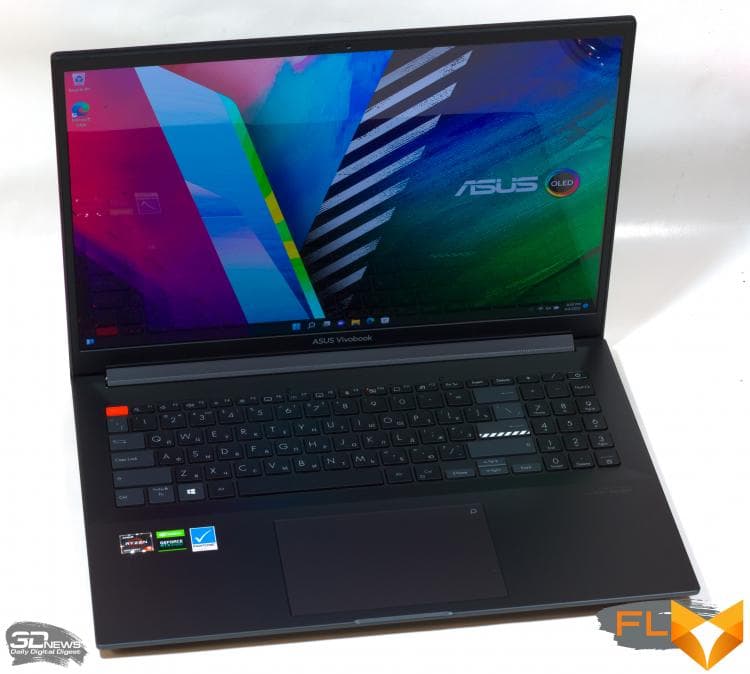
The design of the device is dominated by clear geometric shapes, and a carved badge with the manufacturer’s logo was placed on the back of the lid. Only the edging of the screen from a simple rough plastic visually cheapens the device. The width of the upper indent made it possible to place a webcam peephole covered with a mechanical shutter without any non-standard solutions. Although the laptop screen is not laminated, its surface is very glossy -only a large margin of brightness helps out in sunlight. The laptop lid can be easily lifted with one hand, but it is impossible to tilt it to an angle of 180 ° (which, however, is not required, because the screen is not touch).
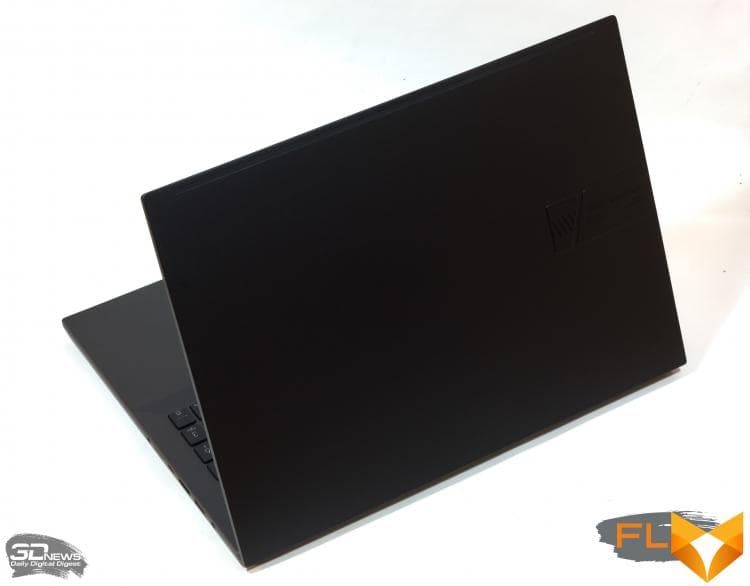
The dimensions of the laptop made it possible to add a number block to the keyboard and keep the same width of all character keys (as usual, only “~” was pressed). Some of the keys differ from the main black mass in color, although the highlighting definitely follows the principles of design rather than functionality. The power button is located in the top row, it has an integrated biometric sensor.
The key mechanics of the VivoBook Pro 16X OLED are pretty good. Although the cones under the caps are tight, “viscous”, the actuation moment is felt well and the scissors stroke is long. It’s nice that, despite the large size and small thickness of the working surface, the deformation of the case when pressed is not so great as to cause obvious discomfort. But the keys are quite loud drumming in the typing process. The backlight of the keyboard is white, with three levels of brightness.
The touchpad is glass and, like many other ASUS laptops, has a switchable LED indication. As a rule, it replaces the numeric keypad, but the VivoBook Pro 16X OLED already has it, so the markup performs a different task. If you slide your finger from the symbol in the upper right corner to the center of the touchpad, the round controller on the left will light up, which works in the same way as in old iPod players. Touching it brings up a circular menu on the screen, with which you can adjust the screen brightness and sound volume, and editing tools appear there in Adobe work applications.
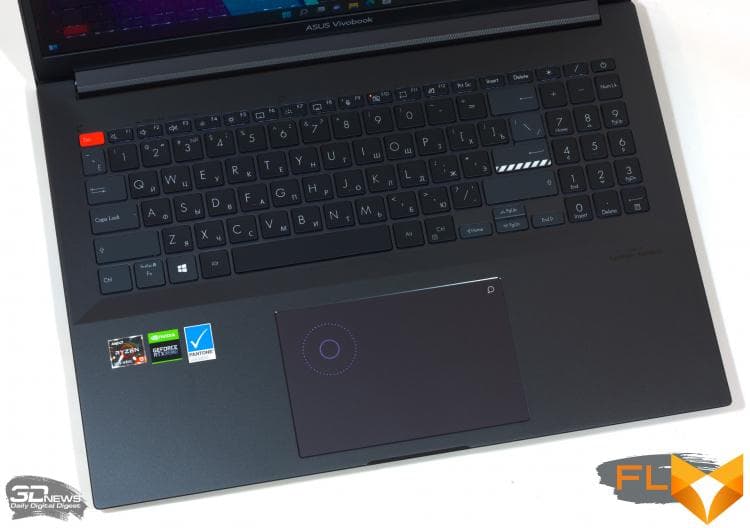
VivoBook Pro 16X OLED does not complain about the number and variety of interfaces for connecting peripherals: there is one USB Type-C port, three Type-A ports, a full-sized HDMI output, an acoustic mini-jack and a microSD card reader slot. But the configuration of the USB connectors is discouraging: two of them operate at a speed of 3.2 Gen 1, which in itself is no longer amazing, and the rest are USB 2.0 at all.

The battery is charged by a proprietary power supply unit of low power – 120 W -and therefore compact.
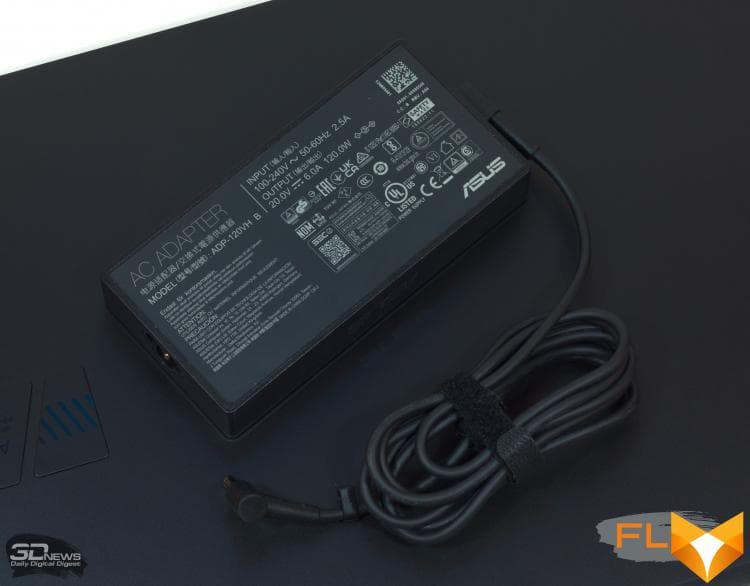
⇡#Internal structure and upgrade options
The insides of the VivoBook Pro 16X OLED are cooled in the same way as smaller, high-end laptops: cold air enters the case through openings in the bottom, and hot air exits between the bottom half body and lid.
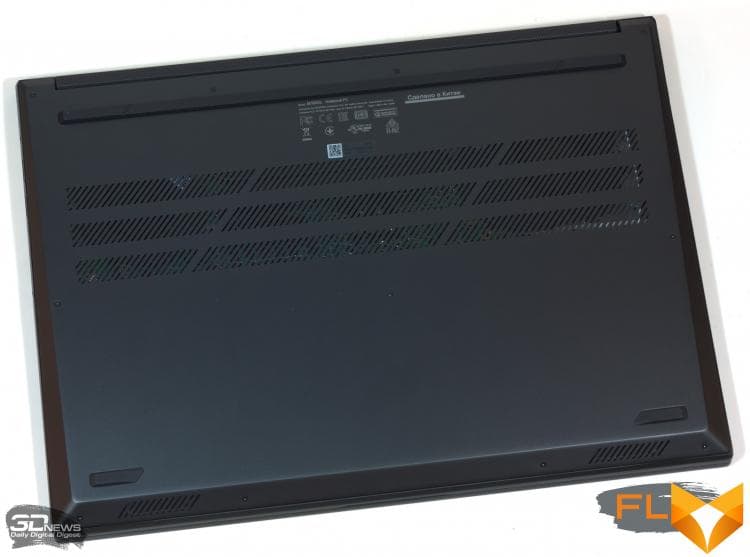
Alas, this is not the only thing that the VivoBook Pro 16X OLED cooling system has in common with thin ultrabook coolers. The radiators here are small, and thin metal plates are used as heat sinks for the CPU and GPU. The power supply system of both chips, except for the VRM chokes of the central processor, is completely devoid of active cooling.

The RAM chips, as we have already noted, are soldered on the laptop motherboard, but there are no RAM expansion slots. The only upgradeable component of the VivoBook Pro 16X OLED is the SSD.
⇡#Testing methodology
| Synthetic tests | |
|---|---|
| Application | Settings |
| 3DMark Time Spy | — |
| Geekbench 5 | — |
| CINEBENCH R23 | — |
| GFXBench 5 (Aztec Ruins — Normal Tier, High Tier) td> | Windows: Vulkan, macOS: Metal |
| fio 3.16 | Sequential Read/Write, Random Read/Write (Unbuffered I/O) |
| Work Applications | |||||
|---|---|---|---|---|---|
| Application | Benchmark | Settings/Notes | API | ||
| Intel Graphics | AMD Graphics | NVIDIA Graphics | |||
| Adobe After Effects 2021 (18.x) | PugetBench for Afer Effects 0.93.2 (test list at link) | — | OpenCL (Windows)/Metal (macOS) | OpenCL (Windows)/Metal (macOS) | CUDA |
| Adobe Photoshop 2021 (22.x) | PugetBench for Photoshop 0.93 (test list at link) | — | OpenGL + OpenCL + Metal (macOS) | OpenGL + OpenCL + Metal (macOS) | OpenGL + OpenCL |
| Adobe Photoshop Lightroom Classic 10.x | PugetBench for Lightroom Classic 0.92 (test list at link) | — | DirectX 12 (Windows) | DirectX 12 (Windows) | DirectX 12 |
| Adobe Premiere Pro 2021 (15.x) | PugetBench for Premiere Pro V0.95.1 (test list at link) | Standard Benchmark (4K) | OpenCL (Windows)/Metal (macOS) | OpenCL (Windows)/Metal (macOS) | CUDA |
| Blackmagic Design DaVinci Resolve Studio 17.x | Puget Systems DaVinci Resolve Studio Benchmark V0.93 (test list at link) | Standard Benchmark (4K), Use GPU for RED R3D (Debayer or Decompression and debayer): best option | OpenCL | CUDA | |
| Blender 2.9x | Class Room demo from Blender Foundation | Cycles renderer. Feature Set: Supported. Tile size: 32 × 32 (CPU) or 256 × 256 (GPU) | N/A (CPU rendering) | OpenCL (Windows)/CPU (macOS) | CUDA/OptX |
| AMD Nissan GTR demo | Radeon ProRender for Blender 3.2.x | N/A | OpenCL (Windows)/Metal (macOS) | OpenCL | |
Display testing is performed using the X-Rite i1Display Pro Plus colorimeter in the DisplayCAL 3 application.
Notebook battery life is measured at a display brightness of 200 cd/m2 in the following usage scenarios:
- web surfing: alternately opening and closing tabs of Computeruniverse.ru and Unsplash.com sites with an interval of 25 seconds in the Google Chrome browser (cache and cookies are disabled); span>
- Continuous playback of 4K HEVC (H.265) video.
⇡#Test participants
The following devices took part in testing:
| Screen | CPU | RAM | GPU | SSD | HDD | Battery | |||
|---|---|---|---|---|---|---|---|---|---|
| ASUS VivoBook Pro 16X OLED (M7600QE) strong> | 16″, 3840 × 2400, OLED | AMD Ryzen 9 5900HX | 8/16 cores/threads, 3.3-4.6GHz | DDR4 SDRAM, 3200 MT/s, 32 GB | NVIDIA GeForce RTX 3050 Ti | 4GB GDDR6 | SK Hynix BC711 (PCIe 3.0 x4) 1024 GB | None | 96Wh |
| Apple MacBook Pro 13″, Late 2020 (A2338 ) | 13.3”, 2560 × 1600, IPS | Apple M1 | 4+4 cores/threads, ≤3.2GHz td> | LPDDR4X SDRAM, 4266 MT/s, 16 GB | Apple G13G (8 cores) | System RAM | Apple AP2048Q (Apple Fabric) 2048GB | None | 58.2Wh |
| Apple MacBook Pro 16″, Late 2021 (A2485 ) | 16.2”, 3456 × 2234, IPS Mini LED | Apple M1 Pro (10 cores) | 8+2 cores/threads, ≤3.2/2.1 GHz | LPDDR5 SDRAM, 6400 MT/s, 16 GB | Apple G13X (16 cores) | System RAM | Apple AP1024R (Apple Fabric) 1024 GB | None | 99.6Wh |
| ASUS ExpertBook B7 Flip (B7402FE) | 14”, 1920 × 1200, IPS | Intel Core i7-1195G7 | 4/8 cores/threads, 2.9-4.6GHz | DDR4 SDRAM, 3200 MT/s, 64 GB | Intel Iris Xe Graphics G7 | 1 GB from system memory | Samsung PM9A1 (PCIe 4.0 x4) 1024GB | None | 63 Wh |
| ASUS ROG Flow X13 (GV301QH-K5228T) | 13.4”, 3840 × 2400, IPS | AMD Ryzen 9 5980HS | 8/16 cores/threads, 3.1-4.8GHz | LPDDR4X SDRAM, 4266 MT/s, 32 GB | NVIDIA GeForce GTX 1650 Max-Q | 4GB GDDR6 | WD PC SN530 (PCIe 3.0 x4) 1024GB | None | 62 Wh |
| GIGABYTE AERO 15 OLED (XD-73RU644SP) | 15.6”, 3840 × 2160, AMOLED | Intel Core i7-11800H | 8/16 cores/threads, 2.3-4.6GHz | DDR4 SDRAM, 3200 MT/s, 32 GB | NVIDIA GeForce RTX 3070 | 8GB GDDR6 | Phison ESR01TBTLG-E6GBTNB4 (PCIe 4.0 x4) 1024GB | None | 99 Wh |
| HP ZBook Studio G7 (1J3W1EA) | 15.6”, 1920 × 1080, IPS | Intel Core i7-10850H | 6/12 cores/threads, 2.7-5.1GHz | DDR4 SDRAM, 2933 MT/s, 16GB | NVIDIA Quadro RTX 3000 Max-Q | 6GB GDDR6 | Samsung PM981a (PCIe 3.0 x4) 512GB | None | 83Wh |
| HUAWEI MateBook 16 (CREM-WXX9) | 16”, 2520 × 1680, IPS | AMD Ryzen 7 5800H | 8/16 cores/threads, 3.2-4.4 GHz | DDR4 SDRAM, 3200 MT/s, 16 GB | AMD Radeon RX Vega 8 | 512MB of system RAM | WD PC SN730 (PCIe 3.0 x4) 512GB | None | 84 Wh |
| Lenovo ThinkBook 16p Gen 2 (20YM000BRU) strong> | 16″, 2560 × 1600, IPS | AMD Ryzen 9 5900HX | 8/16 cores/threads, 3.3-4.6GHz | DDR4 SDRAM, 3200 MT/s, 32 GB | NVIDIA GeForce RTX 3060 | 6GB GDDR6 | WD PC SN730 (PCIe 3.0 x4) 1024GB | None | 71 Wh |
⇡#Screen quality
The 3840 × 2400 matrix installed in the ASUS laptop is remarkable not only for the “infinite” contrast inherent in OLED technology, but also for the high level of brightness – up to 406 cd/m2, and filling the whole screen with white causes only a slight drop to 401 cd/m2.
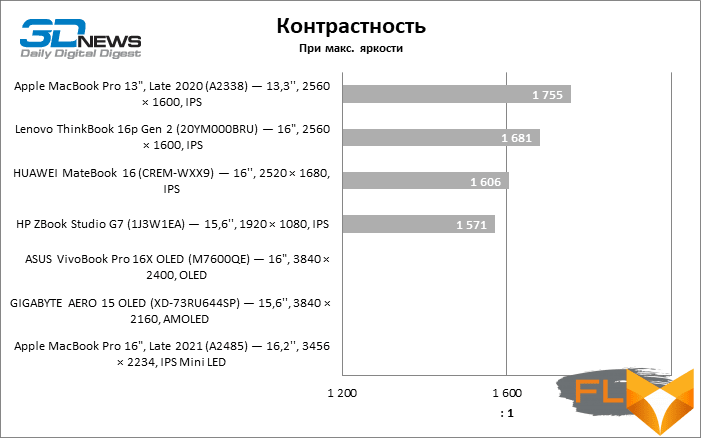
The panel’s wide range of hues provides nearly complete coverage of P3 and Adobe RGB standards.
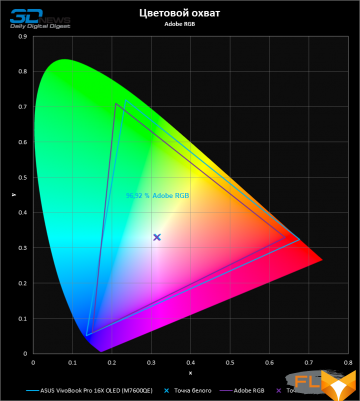 | 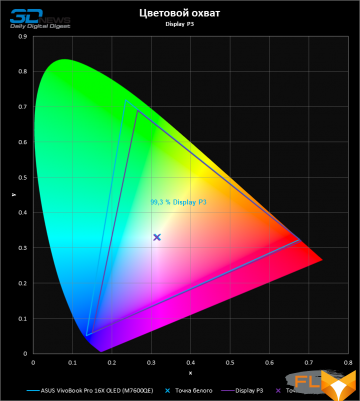 |
The white point is close to the D65 reference value, and the color temperature is close to 6500K throughout the gray scale.
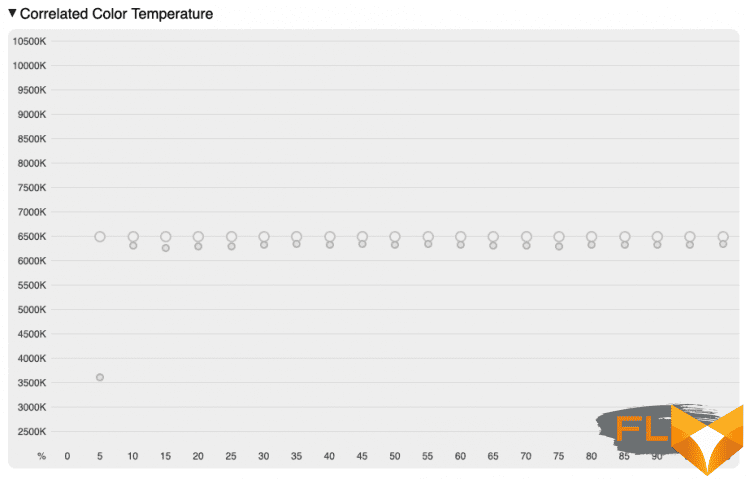
The operating system has a color profile that tells applications that have a color correction system the characteristics of the matrix. The results of further tests show how closely this profile matches the screen parameters of the VivoBook 16X OLED sample. Apparently, ASUS does not perform individual profiling, hence the somewhat chaotic shape of the gamma correction curve.
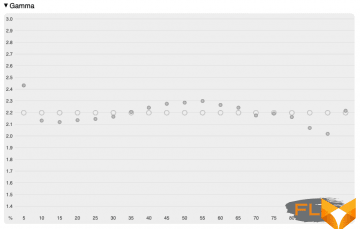 | 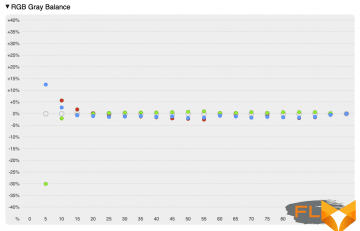 |
On the other hand, the gray balance turned out to be quite satisfactory, and, as a result, the screen showed good color accuracy. Professionals will likely have to calibrate it themselves, but for the not-too-critical work with color, the VivoBook 16X OLED is ready right out of the box. The only pity is that the pre-installed software does not allow you to limit the color gamut to sRGB space. As a result, the interface and content of applications that do not know how to handle color profiles (and most of them in the Windows environment) inevitably look oversaturated.
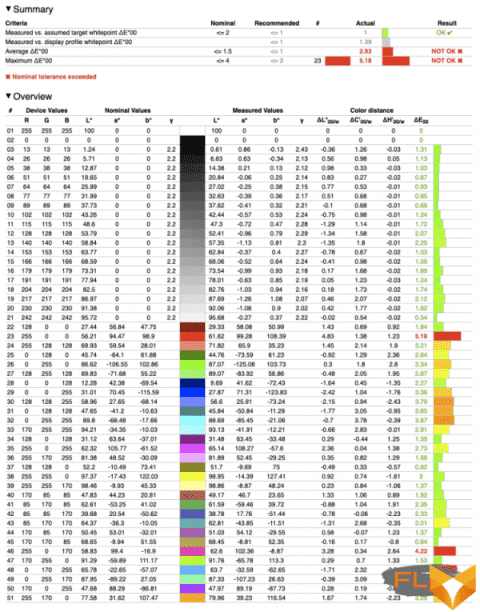
⇡#Clock speeds, temperature and noise level
The VivoBook 16X OLED test unit comes with a top-of-the-line Ryzen 9 5900HX CPU, and the laptop’s control software offers a choice of three component power modes. In the maximum performance mode, the CPU fully utilizes the headroom specified by AMD (54W) with eight cores continuously loaded, and the clock speed has stabilized at a high level of about 3.65 GHz. In turn, discrete graphics GeForce RTX 3050 Ti, rated at TBP from 30 to 80 watts, consumes 51 watts of power and operates at a clock frequency of 1.65 GHz. When the CPU and GPU are loaded at the same time, the power consumption of the CPU drops to 40W and the clock frequency drops to 3.25GHz while the GPU parameters remain the same.
Under maximum load, the CPU reaches 90°C, which is an excellent result among most laptops, for which even 100°C is forced to be considered normal. In turn, the temperature of a compact GPU does not exceed 76 ° C. The only pity is that the modest size of heat sinks and radiators does not allow to combine efficient cooling with low noise level, which exceeds 51 dBA in maximum speed mode.
| Clock speeds under load | ||||||||
|---|---|---|---|---|---|---|---|---|
| Cinebench R20 (max thread no) | Blender 2.9x (GPU rendering) | Cinebench R20 (max thread no.) + Blender 2.9x | ||||||
| CPU clock speed, MHz | GPU clock speed, MHz | CPU clock speed, MHz | GPU clock speed, MHz | |||||
| Medium | Max | Medium | Max | Medium | Max | Medium | Max | |
| ASUS VivoBook Pro 16X OLED (M7600QE) -aMD Ryzen 9 5900HX / NVIDIA GeForce RTX 3050 Ti – Performance Mode | 3672 | 3693 | 1652 | 1695 | 3269 | 3369 | 1615 | 1680 |
| ASUS VivoBook Pro 16X OLED (M7600QE) -aMD Ryzen 9 5900HX / NVIDIA GeForce RTX 3050 Ti – Standard Mode | 3400 | 3469 | 1443 | 1597 | 2712 | 2745 | 1266 | 1620 |
| ASUS VivoBook Pro 16X OLED (M7600QE) -aMD Ryzen 9 5900HX / NVIDIA GeForce RTX 3050 Ti – Whisper Mode | 1934 | 1976 | 210 | 210 | 1398 | 1412 | 210 | 210 |
| CPU and GPU power consumption | ||||||||
|---|---|---|---|---|---|---|---|---|
| Cinebench R20 (max thread no) | Blender 2.9x (GPU rendering) | Cinebench R20 (max thread no.) + Blender 2.9x | ||||||
| CPU Wattage | GPU power consumption (SoC as a whole, if integrated), W | CPU Wattage | GPU power consumption (if discrete), W | |||||
| Average | Max | Medium | Max | Medium | Max | Medium | Max | |
| ASUS VivoBook Pro 16X OLED (M7600QE) -aMD Ryzen 9 5900HX / NVIDIA GeForce RTX 3050 Ti – Performance Mode | 54 | 56 | 51 | 51 | 40 | 42 | 52 | 52 |
| ASUS VivoBook Pro 16X OLED (M7600QE) -aMD Ryzen 9 5900HX / NVIDIA GeForce RTX 3050 Ti – Standard Mode | 44 | 45 | 42 | 42 | 25 | 25 | 41 | 41 |
| ASUS VivoBook Pro 16X OLED (M7600QE) -aMD Ryzen 9 5900HX / NVIDIA GeForce RTX 3050 Ti – Whisper Mode | 15 | 15 | 12 | 12 | 12 | 12 | 12 | 12 |
Note The measurement is performed after the device has warmed up and all parameters have stabilized.
“Standard” power mode limits CPU power to 44W under continuous multi-threaded load, but the chip maintains a high clock speed of 3.4GHz. The appetites of the discrete graphics core also drop to 42W and sustained clock speeds to 1.45GHz. The difference between “performance” and “standard” modes is most pronounced when the CPU and GPU are running at the same time, when the CPU has to slow down to 25 W and 2.7 GHz. But the noise of the laptop is not as strong as at full speed.
Finally, the “quiet” mode brings the power consumption of the main components of the laptop to the standards of compact ultrabooks: the CPU consumes no more than 15 W of power and operates at a clock frequency of about 2 GHz, and when loaded simultaneously with the GPU, its parameters are 12 W and 1.4 GHz. The graphics processor is also allocated a budget of 12 W, which, by and large, deprives discrete graphics of any value, because the clock frequency of the video chip in “quiet” mode is only 210 MHz. But the name of the mode does not deceive: now the laptop works almost silently.
Note Idle and sustained CPU (SoC) temperature all CPU cores
Note GPU Idle Temperature (SoC) and GPU Long Load
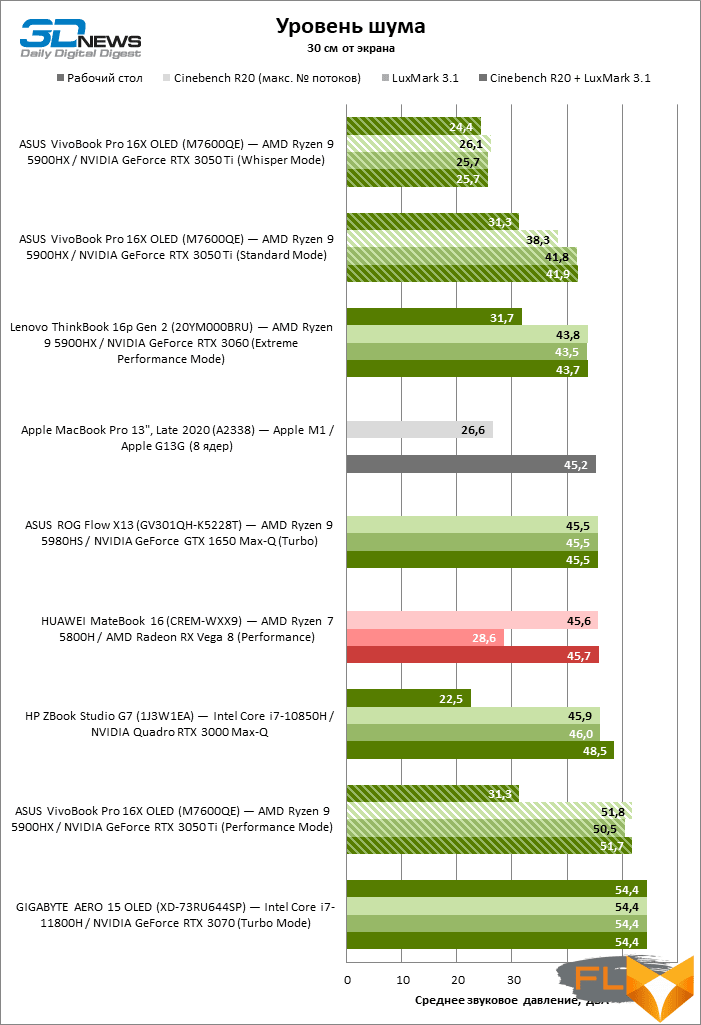
⇡#Synthetic benchmarks
Let the Ryzen 5000-series processors belong to the outgoing generation of notebook CPUs, the Ryzen 9 5900HX chip remains one of the highest performance solutions for general purpose laptops and workstations. Only the higher-clocked Ryzen 9 5900HX brothers in architecture, as well as the ten-core versions of the Apple M1 in modern MacBook Pros, can boast the best performance in an all-core marathon load. Only in tasks of a short, explosive nature, the 11th generation Intel chips manage to seize the lead. And with a power reserve of 54W, the VivoBook 16X OLED CPU is close to Intel counterparts in single-threaded performance.
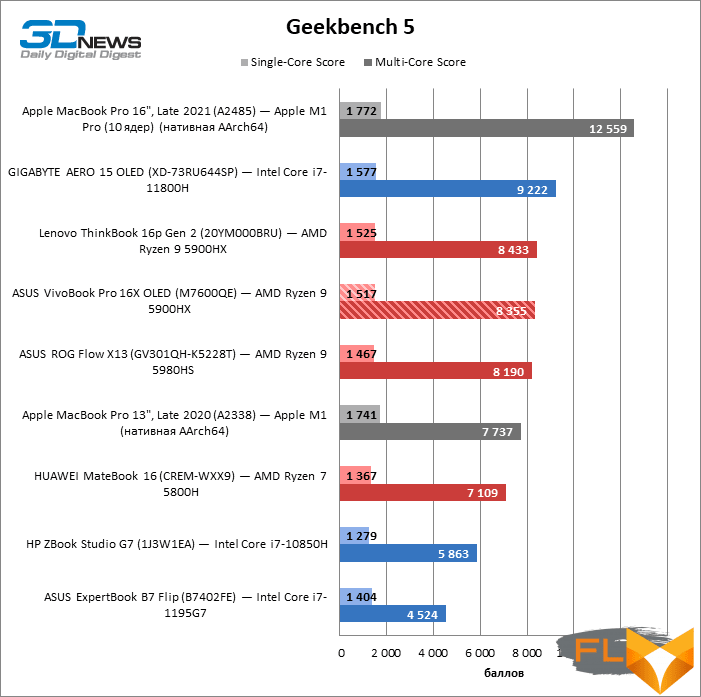
GeForce RTX 3050 Ti with moderate power settings set by ASUS represents a major step forward from GeForce GTX 1650 Max-Q-level discrete graphics and GPUs found in mobile workstations, is an analogue of the Quadro RTX 3000. On the other hand, the RTX 3050 Ti is noticeably behind the integrated Apple M1 Pro video core, and even more so the next older NVIDIA models – the GeForce RTX 3060 and RTX 3070.

⇡#Performance in production applications
CPU testing in Blender is a direct indicator of robust multi-threaded performance. As a result, the VivoBook 16X OLED earned a deservedly high spot on the render time chart. Only laptops based on the Apple M1 Pro, as well as older (or pre-overclocked) eight-core Ryzen chips, achieved the best results, and even then their advantage over the VivoBook 16X OLED is already small.
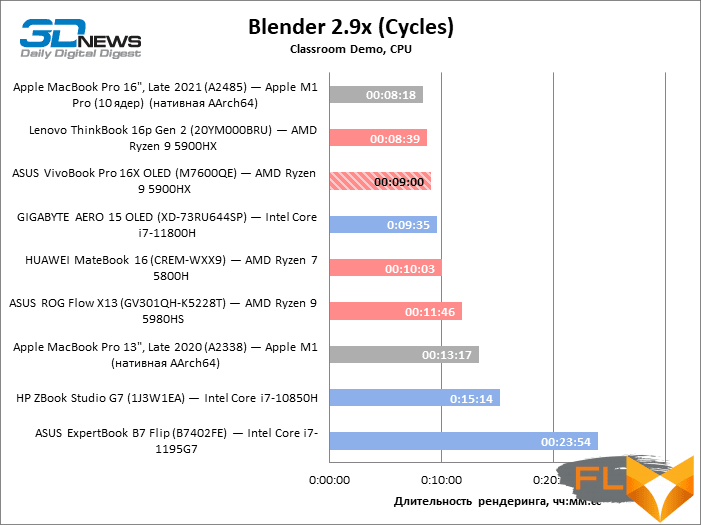
Be that as it may, the VivoBook 16X OLED discrete graphics make this job easier to handle, especially when the GPU’s RT cores are involved. In this case, the GeForce RTX 3050 Ti is predictably inferior in performance to the older models of the 30th NVIDIA line, but at the same time it significantly outperforms economical solutions like the GeForce GTX 1650 Max-Q.


The Ryzen 9 5900HX CPU performs even better in the latest version of Blender, and the GeForce RTX 3050 Ti GPU showed a twofold advantage over the Apple M1 Pro graphics.
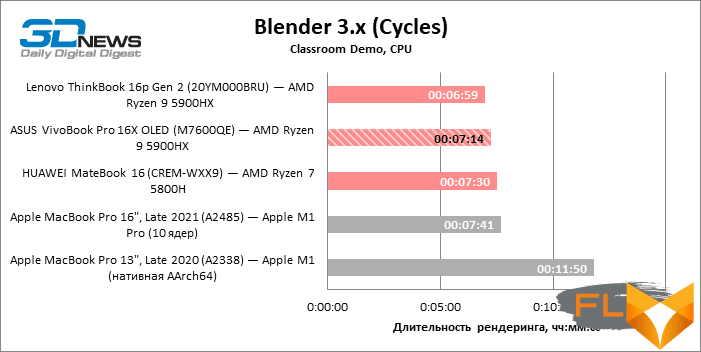

Lightroom benchmarks have traditionally been dominated by devices with Intel processors, but powerful red machines like the VivoBook 16X OLED are no longer so far behind the blue leaders, even though the ASUS laptop has a low-power (compared to the GeForce RTX 3070 , which is equipped with a laptop on the top line of the diagram of results) a discrete video adapter.
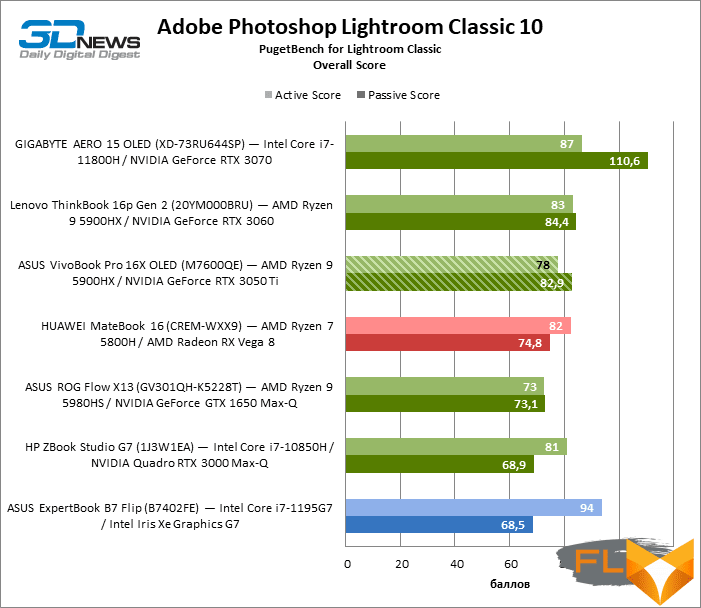
Note Scores are calculated as a percentage of the performance of a reference workstation with Intel Core i9-9900K, NVIDIA GeForce RTX 2080 and 64GB RAM.
In Photoshop, the difference between the VivoBook 16X OLED and an Intel-based workstation is even smaller than in Lightroom, and the performance of the graphics core is not critical.
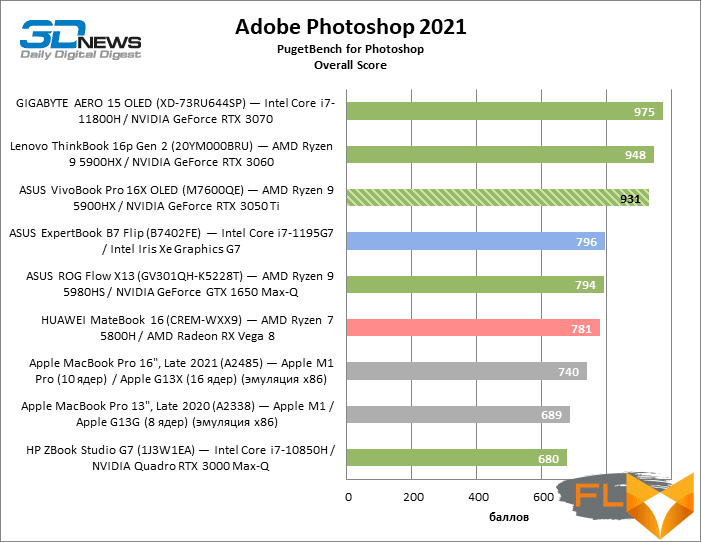
Note Scores are calculated as a percentage of the performance of a reference workstation with Intel Core i9-9900K, NVIDIA GeForce RTX 2080 and 64 GB of RAM times 10.
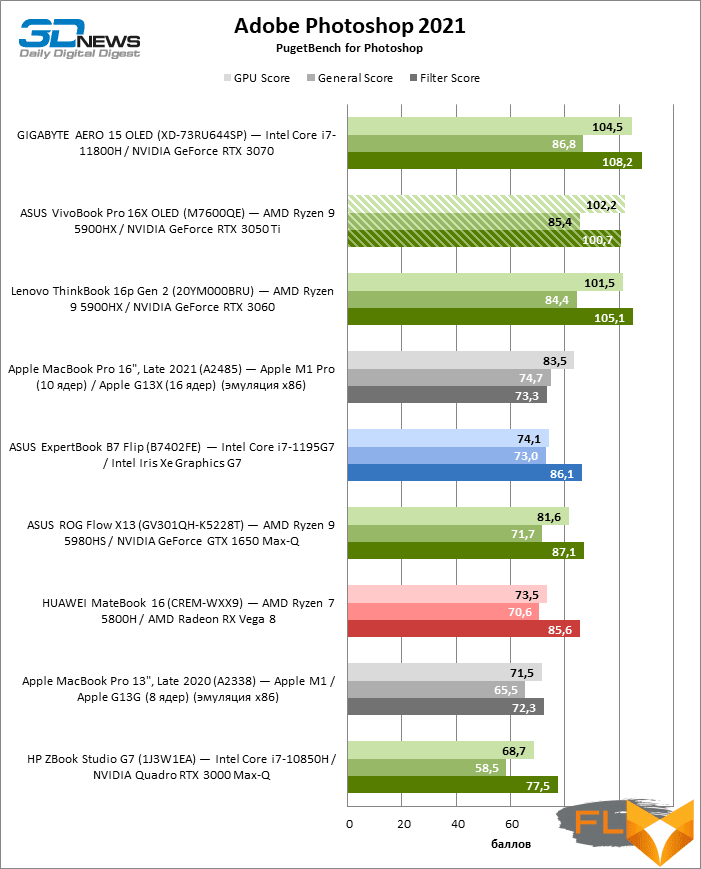
Note Scores are calculated as a percentage of the performance of a reference workstation with Intel Core i9-9900K, NVIDIA GeForce RTX 2080 and 64GB RAM.
For complex Premiere Pro projects, on the other hand, a powerful graphics card is useful, but in terms of aggregate performance metrics, the VivoBook 16X OLED is almost on par with a machine with the same CPU, but the GeForce RTX 3060 instead of RTX 3050 Ti. The combination of a powerful Intel CPU and GeForce RTX 3070, as well as a MacBook Pro based on the Apple M1 Pro, performed noticeably better in the test.

Note Scores are calculated as a percentage of AMD Ryzen 9 5900X reference workstation performance, NVIDIA GeForce RTX 3080 and 64 GB of RAM times 10.
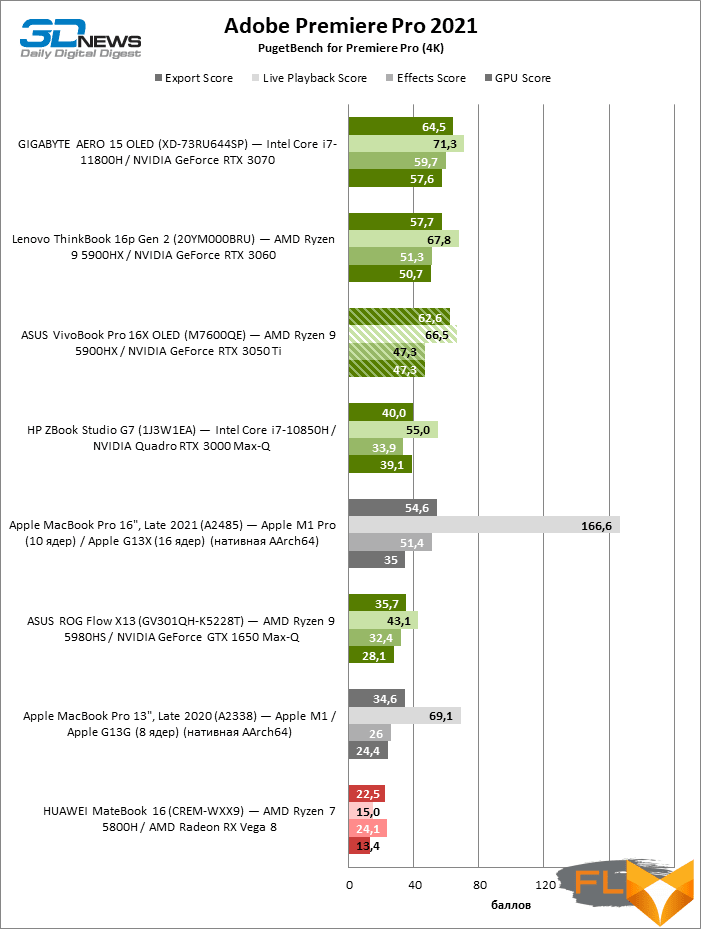
Note Scores are calculated as a percentage of AMD Ryzen 9 5900X reference workstation performance, NVIDIA GeForce RTX 3080 and 64 GB RAM.
The GeForce RTX 3050 Ti is fast enough to play 4K video at 60 FPS smoothly, but in multi-camera mode, only the M1 Pro system can do this task. But the VivoBook 16X OLED does not complain about the export speed of the project: among the compared devices, only a laptop equipped with the GeForce RTX 3070 performs encoding faster.
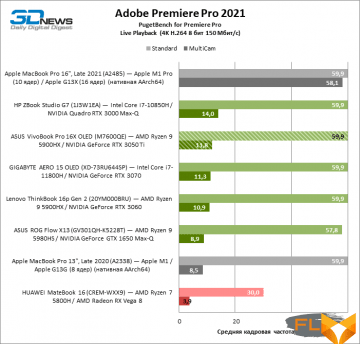 | 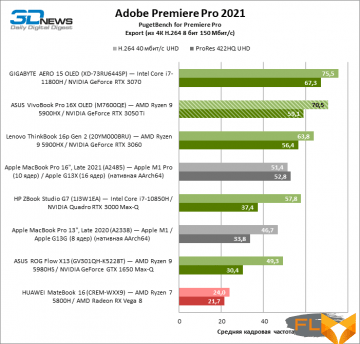 |
The speed of Adobe After Effects also depends heavily on the graphics card, so the benchmark put a workstation with a GeForce RTX 3070 on board in the first place, but, however, does not see much difference between The GeForce RTX 3050 Ti used in the VivoBook 16X OLED and the RTX 3060 are bundled with exactly the same CPU.
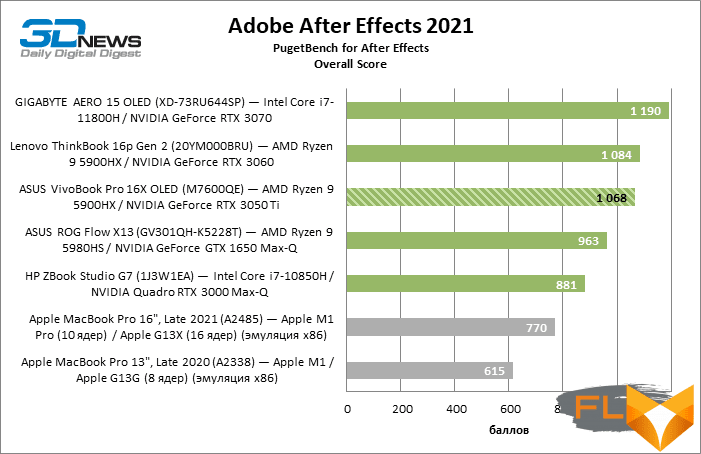
Note Scores are calculated as a percentage of the performance of a reference workstation with Intel Core i9-9900K, NVIDIA GeForce RTX 2080 and 64 GB of RAM times 10.
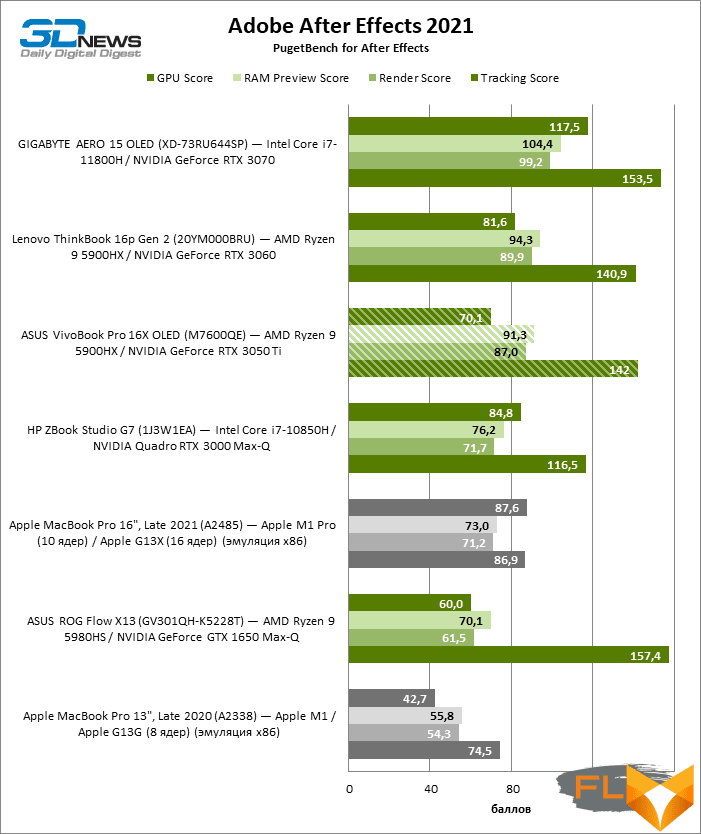
Note Scores are calculated as a percentage of the performance of a reference workstation with Intel Core i9-9900K, NVIDIA GeForce RTX 2080 and 64GB RAM.
The final and most difficult test in the list of working applications was the DaVinci Resolve video editor. Unlike the similar Premiere Pro benchmark, it is fundamentally important here that the graphics card has at least 6 GB of its own memory, and the 4 GB GeForce RTX 3050 Ti simply could not complete one of the test sequences – triple temporal noise reduction. As a result, the VivoBook 16X OLED is significantly inferior to all rivals in terms of aggregate performance, including machines with similar graphics cards in raw processing power – the GeForce RTX 3060 and Quadro RTX 3000 Max-Q.
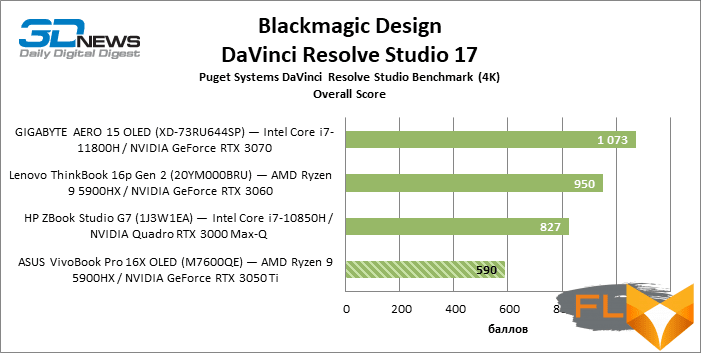
Note Scores are calculated as a percentage of the performance of a reference workstation with Intel Core i9-10900K and NVIDIA TITAN RTX multiplied by 10.
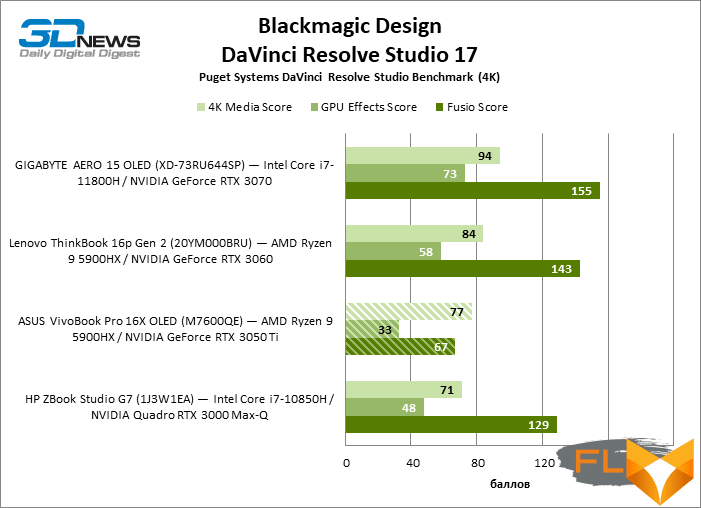
Note Scores are calculated as a percentage of the performance of a reference workstation with Intel Core i9-10900K and NVIDIA TITAN RTX.
⇡#SSD Performance
As a ROM for the VivoBook 16X OLED, ASUS engineers chose a rather rare but successful SSD branded SK Hynix BC711. This drive delivers high linear read and write throughput within the limits of the PCI Express 3.0 interface, good (compared to common analogs) random read speed, and excellent random write speed.
 | 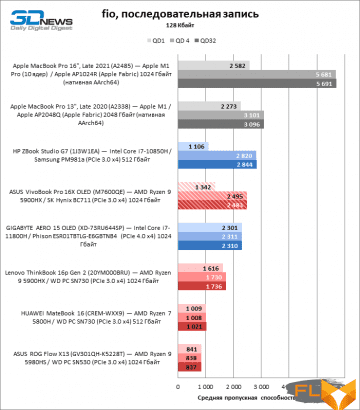 |
 | 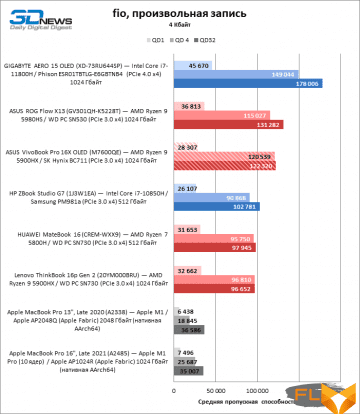 |
⇡# Battery Life
The battery capacity of the VivoBook 16X OLED (96 Wh) is close to the maximum for consumer laptops, and the power of the filling in the “quiet” power consumption drops to the level of the smallest ultrabooks. The result is an impressive battery life of nearly 11 hours of continuous web surfing or 4K movie playback.
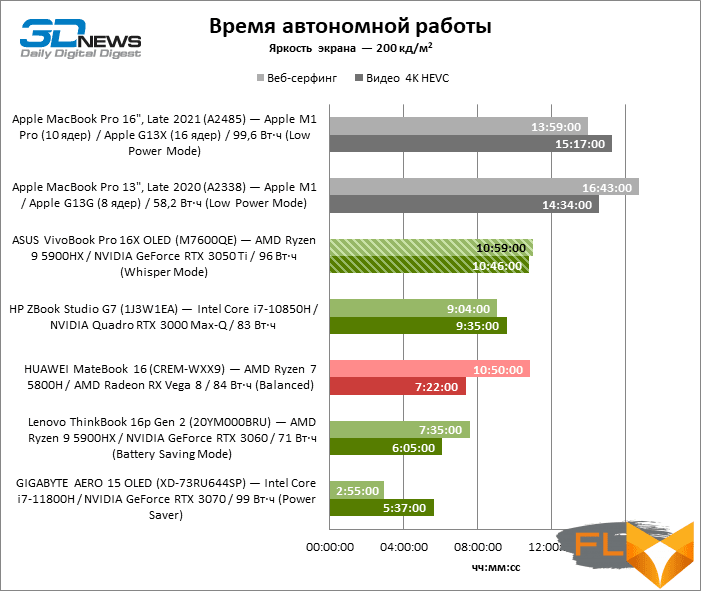
⇡#Conclusions
The VivoBook 16X OLED laptop, or rather, a variation of this device based on the AMD platform, has become another illustration of the virtues of “red” silicon in the field of mobile workstations, where until recently they were considered the gold standard Intel solutions. While new-generation mobile CPUs have not yet become widespread, rare chips can compete in speed with Ryzen 5000-series octa-cores, but here the processor is running at full power given by the specifications. Well, the discrete graphics GeForce RTX 3050 or RTX 3050 Ti does an excellent job with the bulk of work tasks, provided that they have enough 4 GB of video memory. Of course, you can not ignore the excellent 16-inch screen, made using OLED technology. Not only does the matrix have 4K resolution and 16:10 aspect ratio, it is very bright and reproduces almost all shades of P3 and Adobe RGB color spaces. Finally, a battery of almost the maximum capacity was installed in the laptop, and the energy saving mode allows you to work on a single charge from morning to evening.
ASUS has been able to pack powerful components and a large battery into a compact and lightweight body, but it comes with a cost: when a laptop is required to perform at its best, the cooling system keeps the CPU and GPU cool but it is very noisy. Finally, modern computers are no longer honored by USB 2.0 ports. The last disadvantage of the VivoBook 16X OLED is mitigated by the democratic cost of the device. The situation on the market is changing rapidly, but at the moment, in terms of price and main characteristics, the ASUS offer undoubtedly outperforms many analogues.
FAQ Asus vivobook pro 16x oled (m7600qe) review
What are the key features of the OLED display in the ASUS Vivobook Pro 16X?
The OLED display in the ASUS Vivobook Pro 16X offers vivid colors and deep blacks, with a 4K resolution that enhances the visual experience, making it ideal for content creation and gaming.
How does the Vivobook Pro 16X OLED perform for gaming?
The Vivobook Pro 16X OLED, with its GeForce RTX 3050 Ti laptop GPU and OLED screen, provides an immersive gaming experience, offering crisp visuals and smooth performance.
What makes the 4K OLED display suitable for content creators?
The 4K OLED display on laptops like the ASUS ZenBook and Vivobook Pro 16X provides accurate colors and high contrast ratios, essential for content creators in video editing and graphic design.
Are gaming laptops with OLED screens becoming more popular?
Yes, gaming laptops with OLED screens, like those with a 4K OLED display, are gaining popularity for their superior color accuracy and contrast, enhancing the overall gaming experience.
Which laptop is considered the best for incorporating an OLED screen?
The ASUS ZenBook and Vivobook Pro 16X are often considered among the best laptops with OLED screens, particularly for their combination of high-quality displays and powerful performance specs.
How does Windows 11 enhance the use of laptops with OLED displays?
Windows 11 enhances the use of laptops with OLED displays by providing improved support for high-resolution screens and advanced color management, benefiting both everyday use and professional applications.
What are the advantages of USB 3.2 Gen 1 in laptops like the ASUS Vivobook Pro 16X OLED?
USB 3.2 Gen 1 in laptops like the ASUS Vivobook Pro 16X OLED offers fast data transfer speeds, which is beneficial for transferring large files quickly, a common requirement in content creation.
Why is the ASUS ZenBook considered a great choice for creators?
The ASUS ZenBook, with features like a 4K OLED screen, up to 32GB of RAM, and powerful processors, is considered a great laptop for creators due to its ability to handle intensive creative software efficiently.
How does the ASUS DialPad enhance the functionality of the Vivobook Pro 16X OLED?
The ASUS DialPad on the Vivobook Pro 16X OLED adds a unique interface for creative professionals, allowing intuitive control over creative software, enhancing productivity in content creation tasks.
What is the general customer and expert review consensus on the ASUS ProArt Studiobook 16 OLED?
Customer and expert reviews generally praise the ASUS ProArt Studiobook 16 OLED for its exceptional 16-inch OLED display, powerful performance with the Ryzen 9 5900HX processor and RTX 3050 Ti graphics, making it a top choice for professionals in creative fields.
How does the ASUS Vivobook Pro 16X OLED perform according to reviews?
The Vivobook Pro 16X OLED review generally praises its high performance, especially with the AMD Ryzen 9 5900HX CPU and NVIDIA RTX 3050 Ti, making it a powerful laptop for both creators and general users.
Is 32GB RAM sufficient for heavy multitasking on the ASUS Vivobook 16X?
Yes, 32GB RAM in the ASUS Vivobook 16X makes it highly capable of handling heavy multitasking and demanding applications, ideal for both professional and personal use.
How does the Surface Laptop compare to the ASUS Vivobook Pro 16X OLED for creative work?
While the Surface Laptop is known for its sleek design and portability, the ASUS Vivobook Pro 16X OLED, with its larger 16-inch OLED screen and more powerful specs, is often preferred for more intensive creative work.
What makes the ASUS Vivobook Pro 16X OLED a suitable creator laptop?
The ASUS Vivobook Pro 16X OLED’s combination of a 16-inch OLED screen, high-performance AMD Ryzen 9 5900HX processor, and powerful graphics makes it a highly suitable laptop for creators, especially in fields like video editing and graphic design.
What are the key features of the ASUS Vivobook Pro 16X OLED’s 16-inch laptop design?
The ASUS Vivobook Pro 16X OLED features a slim, stylish design with a 16-inch OLED screen that offers vivid colors and deep blacks, making it both aesthetically pleasing and functional for a variety of uses.
How does the AMD Ryzen 9 5900HX CPU enhance the ASUS Vivobook Pro 16X OLED’s performance?
The AMD Ryzen 9 5900HX CPU in the ASUS Vivobook Pro 16X OLED significantly enhances its performance, providing fast processing speeds that are ideal for demanding applications and multitasking.
What do customer reviews say about the ASUS Vivobook Pro 16X OLED’s 16-inch OLED screen?
Customer reviews often highlight the ASUS Vivobook Pro 16X OLED’s 16-inch OLED screen for its exceptional color accuracy and contrast, making it ideal for creative professionals who require precise color representation.
How does the ASUS Dial feature add functionality to the ASUS Vivobook Pro 16X OLED?
The ASUS Dial feature in the Vivobook Pro 16X OLED adds enhanced functionality, allowing users to intuitively control creative software and adjust settings, thereby improving the overall user experience.
In what ways does the NVIDIA RTX 3050 Ti contribute to the ASUS Vivobook Pro 16X OLED’s capabilities?
The NVIDIA RTX 3050 Ti in the ASUS Vivobook Pro 16X OLED contributes significantly to its capabilities, offering robust graphics performance that is crucial for tasks like 3D rendering, video editing, and gaming.
What makes the ASUS Vivobook Pro 16X OLED stand out as a first laptop choice for creators?
As a first laptop choice for creators, the ASUS Vivobook Pro 16X OLED stands out for its powerful combination of an AMD Ryzen 9 5900HX processor, NVIDIA RTX 3050 Ti graphics, and a vibrant 16-inch OLED screen, making it highly versatile for various creative tasks.


